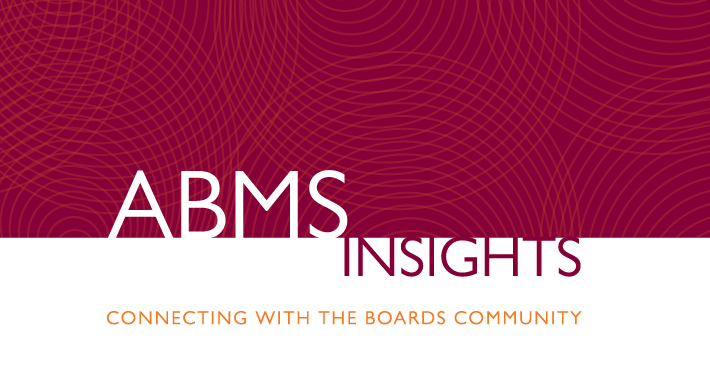
Research on the impact of the changing health care ecosystem on professionalism, the physicians’ view of engagement, and components of a remediation program were topics addressed by three speakers at ABMS Conference 2020 – Virtual held this past September.

Differing perspectives of professionalism in today’s health care business climate could threaten professionalism if health care systems do not support their physicians, noted Therese Zink, MD, MPH, a Professor in Family Medicine and Public Health at Brown University.
Dr. Zink and colleagues conducted telephone interviews with three groups of stakeholders from for-profit and non-profit health care systems in urban and rural settings across the country. The cohorts are health care executives (HCEs), primary care physicians (PCPs), and patients. The study was funded by the American Board of Family Medicine Foundation’s Center for Professionalism and Value in Health Care.
Positive aspects of business pressures cited by the HCEs and PCPs include the linking of quality and cost in value-based care, the focus on developing effective teams and a culture of teamwork, and the emphasis on patient-focus factors highlighting understanding and enhancing the patient’s health care experience. The latter include same day access, continuity of care, online communication portals, and proactive outreach.
They considered the negative aspects of business pressures to be the complexity of the health care system and the volume and productivity pressures on primary care. Today’s care delivery arrangements with electronic health records (EHRs) pose challenges and workload issues due to documentation requirements and prior authorizations. Additionally, the existing payment model, which does not reflect new care delivery models, undervalues PCPs.
Currently, some organizations support professionalism by:
- Offering interventions that maximize physician time with patients and limit their data entry load by hiring scribes or additional nursing staff.
- Improving EHR efficiency.
- Ensuring meeting time is worthwhile and is used to “align with mission, purpose and values.”
- Educating non-physician executives about clinical realities and bringing practicing physicians to the decision table.
- Addressing burnout and wellness in physicians and other staff members and measuring/monitoring it regularly with such tools as the Mayo Well-Being index.
- Approaching professionalism breaches as learning opportunities, for example, by promoting a “Just Culture approach.”
When physicians do not receive organizational support, Dr. Zink said, they devise self-directed tactics, such as engaging in administrative tasks (e.g., interviewing support staff and adjusting their own schedules); moving from a productivity-based salary to a flat salary; and cutting back on clinical time.
Patients, however, just want their individual needs recognized by physicians who are personable, knowledgeable, and straight-forward as well as those who “listen and act on what they hear.” Patients equate feeling better with receiving good care, she said. Patients blame insurers — not the PCPs or health care organizations — for barriers to good care. They appreciate their own PCP’s efforts and while some explicitly recognize the PCP as an advocate, they also promote patient self-advocacy. However, younger patients tend to value access over continuity.
Moving forward, organizations must actively support their physicians, Dr. Zink concluded. Both HCEs and PCPs suggested doing so in the following ways:
- Pursue payment reform so time and productivity do not drive physician payment.
- Eliminate unnecessary data entry and busy work so physicians can focus on their patients.
- Educate individuals at all training levels about professionalism and the social contract (commitment physicians make to patients).
- Engage physicians in leadership roles, decision-making about organizational culture and processes, and implementation of changes.
- Seek comprehensive patient input and encourage patients to advocate for themselves.
- Elicit meaningful input from patients on the boards of patient-centered medical homes and accountable care organizations.

Another study, this one based in Canada, looked at physician engagement, culture, and well-being. Many hospitals in Ontario are struggling with understanding the term physician engagement, said Melissa Prokopy, LLB, Director of Legal, Policy and Professional Issues at the Ontario Hospital Association (OHA). Most physicians are paid fee-for-service through a public health plan. While physicians are engaged with patient care, they are often not engaged with the hospital or the broader system, she noted. There is limited shared learning among hospitals and a distinction between work engagement and physician engagement.
Having a clear understanding of physician engagement will enable health care organizations to define, measure, and improve it at the patient, organization, and system levels. They want to understand how a physician’s individual characteristics, work environment, attitudes, and behaviors affect outcomes at the various levels, she explained. For example, a physician who is pessimistic and has perceived job stress could provide poor quality care, resulting in medical errors.
Ms. Prokopy and colleagues conducted a conceptual analysis by using a literature review of 175 articles to define work engagement. She learned that the term physician engagement is rarely defined, with only 18 articles offering some definition. Examples include “the extent to which the physician actively participates in,” “the degree to which an employee is satisfied in their work,” and “commitment in supporting and encouraging high quality care.”
The study involved interviewing 1,100 physicians across Canada. Fifty-six percent of respondents were male, 70 percent had 11-plus years of practice, 54 percent had worked for their current location for 11-plus years, and 44 percent were paid fee-for-service.
They were asked about administrative issues, well-being/burnout, co-worker relationships, incentives and opportunities, work engagement, quality improvement, and process and development, among others. Respondents ranked empowerment the highest, followed by work engagement and co-worker relationships. Work environment, well-being, and senior leadership were ranked the lowest.
Thirty percent of respondents reported receiving constructive feedback from senior leadership; 40 percent agreed that senior leadership listens to their views, takes concerns seriously, and consistently tackles unacceptable behavior; 44 percent feel well supported, have two-way communication, trust senior leadership, and are held accountable for achieving results; and 55 percent feel senior leadership treats them with respect.
OHA plans to release a national report about the findings. In a select number of hospitals, a post COVID-19 one-year longitudinal review is planned to better understand the impact of the pandemic on physician engagement. Next, targeted focus groups/interviews will be carried out to better understand the challenges and opportunities of physician engagement from the perspectives of both physicians and hospital administrators. OHA will then develop and disseminate a toolkit of hospital case studies/best practice.

Lapses of professionalism — whether they are small infractions that reach critical mass or egregious behaviors — are disconcerting because they can affect patient care and safety within the context of medicine as a team sport, stated Betsy White Williams, PhD, MPH, Clinical Program Director of the Professional Renewal Center®, and Clinical Associate Professor Department of Psychiatry in the School of Medicine at the University of Kansas. To address professionalism transgressions, the nature and scope of the problem as well as contributing factors must be assessed. Dr. Williams uses a biopsychosocial assessment model along with consideration of level of performance within each of the American Board of Medical Specialties/Accreditation Council for Graduate Medical Education (ABMS/ACGME) core competency areas.
Key assessment components include biopsychosocial data, knowledge and skills gaps, and insight (e.g., comparing oneself to other assessments and observation). Assessment data can facilitate an understanding of the various factors that contribute to the problematic behavior(s). Most helpful are external data clarifying the nature of problematic behavior(s) and learner data on insight, emotional competency, and self-efficacy. All these components are used to develop a treatment/remediation program and conduct ongoing assessment both during and post intervention, she said.
Overall, the goals of a remediation program are to:
- Address medical and psychiatric issues (if present).
- Increase insight into contributory factors and negative sequelae of problematic behavior.
- Increase knowledge and skills in ABMS/ACGME core competency areas.
- Increase understanding of behavioral expectations in their current health care environment as well as the broader health care environment.
- Increase knowledge about elements of verbal and non-verbal communication.
- Increase skills (e.g., emotional competency, frustration tolerance, communication, self-efficacy, resilience).
- Deliver treatment/remediation in a way that increases the likelihood new skills will be implemented into practice.
A remediation program involves a small group that uses a multi-modal, interactive format, Dr. Williams said. Social learning theory is incorporated into the group and individual model design. That means the program offers ongoing opportunities for feedback, exposes participants to role models (e.g., faculty), and provides opportunities for mastery experiences increasing a participant’s sense of self-efficacy. Activity goals include ensuring knowledge into practice by scheduling reinforcement sessions over the course of a year and using a variety of assessment data. Think of it in terms of Miller’s Pyramid of Clinical Competency (i.e., knows, knows how, shows, and does), she said.
Regarding remediation programs, Dr. Williams stressed that “one size does not fit all.” There are many contributory factors to professionalism transgressions, and it is essential to understand those to effectively treat/remediate physicians. The vast majority of those referred for professionalism lapses are remediable/treatable, she noted. However, because they are returning to the system that referred them, it is necessary to consider system issues and how those might enhance or jeopardize continuity of the desired behavioral changes. Optimally there can be a system component as part of the overall intervention plan to ensure continuity, Dr. Williams concluded.
© 2020, American Board of Medical Specialties® (ABMS®).
